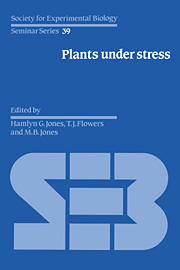Book contents
- Frontmatter
- Contents
- Contributors
- Preface
- 1 Introduction: some terminology and common mechanisms
- 2 The impact of environmental stresses on ecosystems
- 3 Whole-plant responses to stress in natural and agricultural systems
- 4 Photosynthesis and gas exchange
- 5 Regulation of growth and development of plants growing with a restricted supply of water
- 6 Stresses, membranes and cell walls
- 7 Desiccation injury, anhydrobiosis and survival
- 8 Molecular biology: application to studies of stress tolerance
- 9 Environmental control of gene expression and stress proteins in plants
- 10 Plant tissue and protoplast culture: applications to stress physiology and biochemistry
- 11 Breeding methods for drought resistance
- 12 Selection for physiological characters – examples from breeding for salt tolerance
- 13 Prospects for improving crop production in stressful environments
- Index
8 - Molecular biology: application to studies of stress tolerance
Published online by Cambridge University Press: 16 March 2010
- Frontmatter
- Contents
- Contributors
- Preface
- 1 Introduction: some terminology and common mechanisms
- 2 The impact of environmental stresses on ecosystems
- 3 Whole-plant responses to stress in natural and agricultural systems
- 4 Photosynthesis and gas exchange
- 5 Regulation of growth and development of plants growing with a restricted supply of water
- 6 Stresses, membranes and cell walls
- 7 Desiccation injury, anhydrobiosis and survival
- 8 Molecular biology: application to studies of stress tolerance
- 9 Environmental control of gene expression and stress proteins in plants
- 10 Plant tissue and protoplast culture: applications to stress physiology and biochemistry
- 11 Breeding methods for drought resistance
- 12 Selection for physiological characters – examples from breeding for salt tolerance
- 13 Prospects for improving crop production in stressful environments
- Index
Summary
Introduction
Research on genetic manipulation of plants has accelerated dramatically during the past five years. This has exploited ‘natural’ gene delivery systems, leading to the development of vectors, and a number of ‘vectorless’ DNA delivery systems. Further, since plants show extensive powers of regeneration it is, for many species, possible to grow whole plants from genetically engineered cells. Formation of flowers on the genetically engineered plants, followed by pollination, fertilisation, embryogenesis and seed set will then lead to the transmission of the acquired gene to the next generation, provided of course that the gene in question is stably incorporated into the host plant's genome.
In this chapter we first discuss the development of systems for delivering DNA to plant cells. The remainder of the chapter then outlines the ways in which molecular genetics can be applied to research on stress tolerance, giving examples where these techniques are being used.
Systems for gene transfer
For a detailed discussion of DNA delivery systems, readers are referred to the recent very comprehensive review by Walden (1988). Here we concentrate on the two methods most used in stress tolerance studies.
Agrobacterium tumefaciens and its tumour-inducing plasmid
Agrobacterium tumefaciens is a soil-dwelling bacterium which readily infects a wide range of dicotyledonous plants, usually gaining entry via a wound site. Infection causes the growth of a tumour, usually at the original infection site (Fig. 1) and once the tumour is established it will grow in the absence of bacterial cells.
- Type
- Chapter
- Information
- Plants under StressBiochemistry, Physiology and Ecology and their Application to Plant Improvement, pp. 131 - 156Publisher: Cambridge University PressPrint publication year: 1989
- 10
- Cited by

